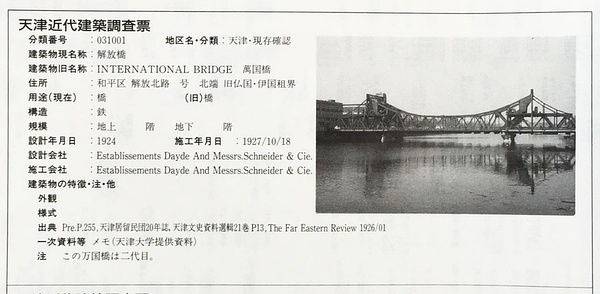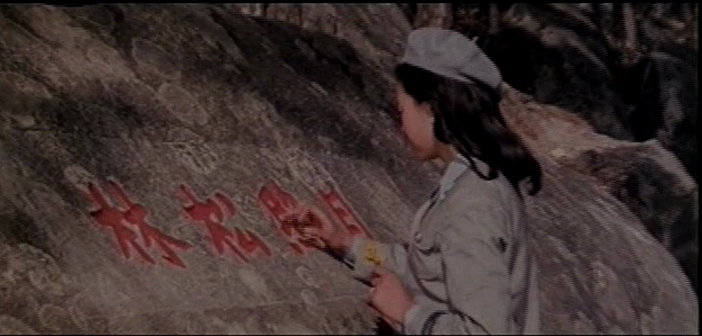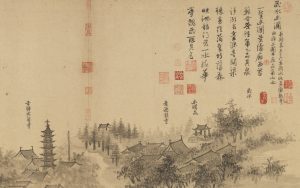In an emailed response to the artist Cai Guo-Qiang’s recent work, Color Mushroom Cloud at the University of Chicago campus, a photograph of which we have included in VMPEA’s Winter Quarter schedule newsletter, Professor Emeritus Norma Field has raised several important questions and issues. We have posted her insights in full below, and we hope her message will encourage people to discuss the issues she has raised:
January 6, 2018
Dear Ms. Lin and the community of Visual and Material Perspectives on East Asia workshop participants:
I hope you will forgive this intrusion from a nonparticipant in your workshop, but as a former member of EALC and, like all of you, citizen of a fragile and precious world, I feel compelled to write about your use of the image of Cai Guo Qiang’s “Color Mushroom Cloud” to announce the winter quarter workshop schedule.
Let me candidly confess at the outset that coming of age in Japan as footage of the impact of atomic bombing (i.e., what happened under the mushroom clouds) became available with the lifting of US censorship, I was initially shocked, even incredulous, when I learned about the University’s plan to stage this detonation. I couldn’t attend the actual event because I was giving a talk elsewhere, but watching the videos, I became, and remain, heartsick.
But let me also quickly add that the source of this distress isn’t confined to a “Japan-US” history. The mushroom cloud, with its huge reach, was a manifestation of atmospheric tests conducted around the world by the nuclear powers—the US, UK, Soviet Union, France, and China—mostly in areas remote from the centers of power, preferably colonial or quasi-colonial sites inhabited by people who didn’t matter and who in any case had no say: Nevada, the Marshall Islands, Polynesia, Christmas Island, Algeria, Xinjiang, Kazakhstan, to give just a few examples. And under each of those clouds—and this is what dismays me about the circulation of the mushroom cloud sprung loose as an iconic image—were human beings and other living things whose health and habitat and livelihood were ravaged, often with intergenerational implications relevant to this day.
The very nature of radioactivity means that the nuclear industry (military and civil) entails potential harm for living things at every stage of its operations, from uranium mining to weapons and fuel (nuclear power) production to testing to waste storage. The production of plutonium in the name of national security in Hanford, Washington, for instance, exposed, at times deliberately, US citizens, workers, farmers, and residents, including African Americans and Native Americans, long after WWII was over.
And since we are at the University of Chicago, it’s worth noting this university’s role in postwar human radiation experiments. You can read about it online in a 1986 House of Representatives Subcommittee Report, American Nuclear Guinea Pigs: Thirty Years of Radiation Experiments on US Citizens. Its author, Edward Markey (currently Senator from Massachusetts), included a particular Chicago experiment among those he found notably “repugnant or bizarre,” one in which students and staff were fed real and simulated fallout from the Nevada Test Site. You can read about it on page 31 of the Report.
These issues may seem removed from the concerns of your workshop, so let me try to bring them closer with a few preliminary, overlapping questions.
(1) We would probably all acknowledge that context matters in our study of objects, including works of art. But which factors, and the degree of relevance of those factors, will be subject to debate. What contextual factors should be considered in assessing “Color Mushroom Cloud”? Given that the work was designed for the commemoration of the 75th anniversary of the first nuclear chain reaction, which was part of the Manhattan Project, originally intended to develop a nuclear weapon to defeat Nazi Germany but transferred to Japan after German surrender, should we consider the more than 200,000 deaths that occurred in Hiroshima and Nagasaki? Precise numbers are necessarily hard to come by, but this figure only includes deaths through December of 1945. It is even harder to estimate the deaths that have occurred in the sites named in the very partial listing above, prolonged in time, in many if not most cases, wilfully undocumented.
(2) How should we evaluate the role of those who commissioned the work? The named actors are UChicago Arts and the Smart Museum. What role did Cai Guo Qiang’s status as an international artist play in their decision? Did it mitigate possible concerns about the work he might propose? What about the fact that he had been awarded the Hiroshima Art Prize? Did it help organizers feel further exempt from the need to scrutinize the project on its own terms, on the terrain of the University of Chicago, for this occasion? And how should we, the public recipients of the resulting product, assess these factors?
(3) Is the distinction of the mushroom cloud its detachability, such that it can be freed of context in a way that no image of the Holocaust, for instance, can? Even if we bracket the controversies, historical and current, and accept, for the sake of argument, that dropping the bomb on Japanese cities was justified for having shortened the war and that the technology later produced the benefit of nuclear power, the actual mushroom cloud itself can only be associated with destruction. American society has shown little tolerance for being shown what happened under the Hiroshima and Nagasaki clouds. An exhibition providing such a glimpse planned for the Smithsonian on the occasion of the 50th anniversary (1995) was canceled after a firestorm of protest and replaced with a display of the fuselage of the Enola Gay.
(4) How much should an artist’s expressed understanding of his works (“intention”) govern reception? For whom and how? Can the artistic intention to redeem or transmogrify succeed with any symbol associated with historically contentious events, not to say atrocities?
(5) What is the role of historical proximity? Despite official America’s rhetoric (the bomb ended the war and saved lives), there are several generations of Americans who both feared nuclear war (the Cuban missile crisis) and questioned the ethics of dropping the bomb, especially in the context of a robust antiwar movement (Vietnam). We all react with different degrees of intensity to potent images depending on what, however vaguely, we know about their references, whether we know anyone who has been impacted, and therefore, the frames of reference that kick in to generate our responses. The first reaction of a Japanese journalist friend from Fukushima to the videos of the “Color Mushroom Cloud” detonation was, “But didn’t the world just witness nuclear explosions–in Fukushima?” The implicit question in her response was, “How could people be cheering and applauding?” I have to admit that Fukushima didn’t come to my mind in this context, even though it has been my abiding concern since retirement.
(6) How does “Color Mushroom Cloud” compare with images that proliferated in American popular culture in the 1950s and 60s? You will find many online. I have been remembering a silver medallion that a young Native American friend, living downwind and downstream of Los Alamos National Laboratory, was given by a Department of Defense or Energy official when he went to an event as a young boy: it depicted the Virgin Mary emerging from a mushroom cloud.
(7) Finally, the question of presumed audience: it’s worth comparing the 57-second University video with the 2-minute video presumably taken by someone in the audience. Neither of these videos, by the way, shows the small group of students who staged a die-in, moving quickly to the base of Moore’s sculpture while all eyes were turned upward. After the smoke dissipated, their gaze returned to the ground where the bodies were strewn.
My thanks to all of you who have read through any part of this. I am writing in the hope of stimulating discussion for our fraught and anxious times.
Sincerely yours,
Norma Field
Emeritus professor, East Asian Languages and Civilizations








